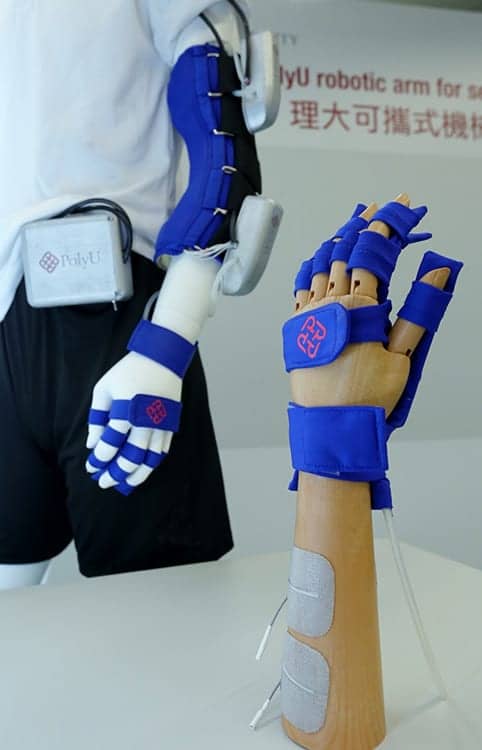
The “mobile exo-neuro-musculo-skeleton,” developed at The Hong Kong Polytechnic University, integrates exoskeleton, soft robot, and exo-nerve stimulation technologies. (Image courtesy of The Hong Kong Polytechnic University)
Researchers from The Hong Kong Polytechnic University (PolyU) have designed a robotic arm that they suggest could help facilitate self-help and upper-limb mobile rehabilitation for stroke patients.
The reportedly first-of-its-kind robotic arm, called a “mobile exo-neuro-musculo-skeleton,” was developed by Dr Hu Xiaoling and her research team in the Department of Biomedical Engineering (BME) of PolyU and features an integration of exoskeleton, soft robot, and exo-nerve stimulation technologies.
Additional features are lightweight design (up to 300g for wearable upper limb components, which are fit for different functional training needs), low power demand (12V rechargeable battery supply for 4-hour continuous use), and sportswear, according to a media release from The Hong Kong Polytechnic University.
Development of the device was inspired by feedback from stroke patients who were discharged from the hospital, who tended to face problems in having regular and intensive rehabilitation training crucial for limb recovery, according to Xiaoling.
“We are confident that with our mobile exo-neuro-musculo-skeleton, stroke patients can conduct rehabilitation training anytime and anywhere, turning the training into part of their daily activities. We hope such flexible self-help training can well supplement traditional outpatient rehabilitation services, helping stroke patients achieve a much better rehabilitation progress,” Xiaoling says.
The working principle of both exoskeleton and soft robot designs is to provide external mechanical forces driven by voluntary muscle signals to assist the patient’s desired joint movement. A conventional exoskeleton is mostly constructed from orthotic materials such as metal and plastic, which stimulate the patient’s external bones. Although it is compact in size, it is heavy and uncomfortable to wear.
Soft robot, made of air-filled or liquid-filled pipes to simulate one’s external muscles, is light in weight but very bulky in size. Both types of structures demand high electrical power for driving motors or pumps. Thus it is not convenient for patients to use them outside hospitals or rehabilitation centers. Combining the advantages of both structural designs, the BME innovative robotic arm is light in weight, compact in size, fast in response and demands minimal power supply. Therefore it is suitable for use in both indoor and outdoor environment, the researchers explain in the release.
The robotic arm further integrates the external mechanical force design with the PolyU-patented Neuro-muscular Electrical Stimulation (NMES) technology. Upon detecting the electromyography signals at the user’s muscles, the device will respond by applying NMES to contract the muscles and exerting external mechanical forces to assist the joint’s desired voluntary movement.
In a trial of the robotic arm, 10 stroke patients demonstrated improvements in their muscle coordination, wrist and finger functions, and reduced muscle spasticity after completing 20 2-hour training sessions using the robotic arm. Further clinical trials will be conducted in collaboration with hospitals and clinics, the researchers add.
The robotic arm consists of components for wrist/hand, elbow, and fingers, which can be worn separately or together for different functional training needs. A sportswear design features washable fabric with ultraviolet protection and good ventilation.
The device can also connect to a mobile application designed to record real-time training data so users can control their training and monitor their rehab progress, as well as serve as a social network platform for stroke patients to communicate online with one another for mutual support.
[Source(s): The Hong Kong Polytechnic University, PR Newswire]





